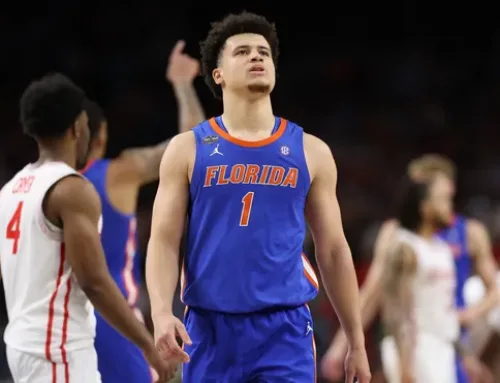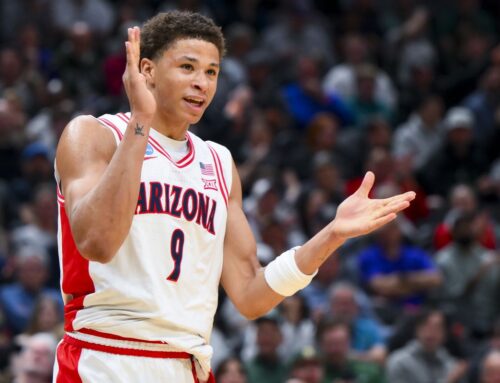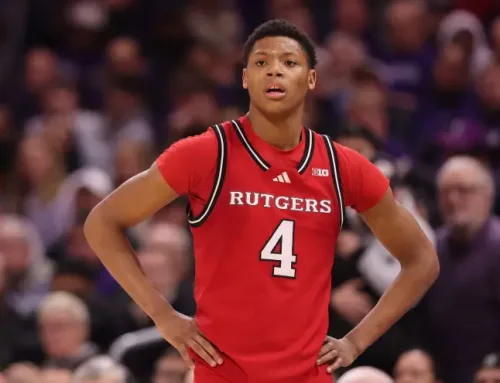By Avi Tyagi
It’s smoke and mirrors season in the 2024 draft cycle. We’re post-lottery and post-combine but team workouts have not ramped up yet. In other words, it’s rumor crumbs season. It’s hard to take any current scuttlebutt seriously. We’re so early in the process, the Pistons haven’t even settled on who their lead decision maker is going to be (and it’s unclear how much power that individual might really have based on the reports of background chaos over the season). With only a month left till the big day, I’m choosing to shoot my shot and prematurely forecast the top 4 picks in the draft. Keep in mind, these are not necessarily the top 4 on my board. I’m simply sifting through the rumors and the draft tendencies of each of the 4 teams, and filtering that info through my own assessment of this class to determine how I think each team might operate.
- Atlanta Hawks: Alexandre Sarr
The Landry-Fields-era-Hawks have a history of drafting domestic players from collegiate juggernauts. Their 4 draft picks thus far: AJ Griffin (Duke), Tyrese Martin (UConn), Kobe Bufkin (Michigan), and Seth Lundy (Penn State). That’s 3 blue bloods and another Big 10 school rolling in CFB cash. Alex Sarr does not fit that bill. On the other hand, he did spend a whole season with Overtime Elite in Atlanta’s backyard. More than that, Sarr is next in the lineage of scrawny modern centers, who can capably put the rock on the deck and make something happen. He’s closer to Mobley on that spectrum than predecessors like Chet or Wemby, but there’s no shame in that. Much like rookie Mobley, Alex might struggle as a rebounder early on and his jump shot is a swing factor. Defensively, he’s still a work in progress in terms of savvy and technique, but few modern center prospects can flip their hips and keep with elite guards and wings the way Sarr projects to. Of all the skinny giants to enter the last few drafts (the aforementioned trio, Claxton, and Dereck Lively), only Wemby offered a higher upside as a switchable big and he’s an alien. At the top of the draft, need is rightfully a minimal factor but if ever there was a team that needed defensive support, it’s Atlanta. Jalen Johnson and Sarr patrolling the rim would solve the Hawks’ frontcourt long term and provide a sturdy foundation to a franchise leaking bottom-half defenses since Jayson Tatum was at Duke.
- Washington Wizards: Stephon Castle
My wild card prediction here. There’s a lot of smoke around other prospects, namely Risacher and Clingan, but I think the triumvirate of Will Dawkins, Michael Winger, and Travis Schlenk ultimately swing for the fences once more. Bilal Coulibaly was an audacious statement in a loaded class. A statement that this front office was willing to operate with patience and bet on a team-first player and excellent athlete who would enter the league as a positive defender and add to their game over 2-3 seasons. Perhaps due to fewer job security concerns looming over their head compared to most GMs at the top of the draft in any sport and a firm belief in their rebuilding timeline, the Wizards brass seems likely to strike the same well twice. In a recent local radio interview, Dawkins specifically states “we can take the time and take the long term approach” with whoever they select and that they aren’t actively seeking “instant gratification”. If ever there was a prospect that fit the bill in this class, it’s Stephon Castle. Let me take you through Castle’s skillset:
- He measured in at the combine at 6′ 5.5″ without shoes on and with a 6′ 9″ wingspan. With shoes on, we’re looking at a 6 foot 7 ball-handling wing, the preeminent archetype every team searches for during draft season.
- Castle brought that length and physicality on defense as a pest on the perimeter and was the only freshman the dominant UConn Huskies leaned on en route to arguably the most dominant tournament run ever.
- He can’t shoot 3s, but his shot doesn’t look broken, his free throw percentage was promising, and it can be argued that he can do everything else at an above average standard.
- If you’ve read any of my past draft reports, you’ll know I love creating prospect filters through Bart Torvik to illuminate what was on film. Here’s Castle’s. Since 2011, there’s a very short list of freshmen to play at least 15 games who are plus-defenders that aren’t foul prone, who showcase at least solid secondary passing, with an offensive arsenal built around slashing, but show enough in their secondary shooting indicators to supply confidence that they can become multi-level scorers.
Games Played ≥ 15; Ast/TO Ratio ≥ 1.5; 2P FG % ≥ 0.5; 3PA/100 Poss ≥ 3; Free Throw % ≥ 0.7; Fouls/40 ≤ 4; Attempts at rim ≥ 120; FG% at rim ≥ 0.6; Far 2 FG% ≥ 0.3; Def. BPM ≥ 2; Class = Fr; Since 2011
De’Aaron Fox
John Wall
Jalen Suggs
Stephon Castle
Castle is far and away the least polished of the bunch and has a ways to go before becoming a proficient 3-point shooting threat, much less a pull-up marksman from deep. He didn’t have the same sort of starring attacking role as the 3 guards on that list, but he’s also big enough and defensively industrious enough to masquerade as a slashing small forward in the meantime. His own stated ambition is to become a point guard himself, but it’ll take time. The upside is apparent and when you consider the history (Dawkins being part of the committee that selected long term projects Giddey and Ousmane Dieng in the lottery range), this might be the perfect fit between organizational goals and Castle’s aspirations.
- Houston Rockets: Reed Sheppard
The Rockets seem like the most likely team of the bunch to trade out of the lottery range. With prospects such as Sengun, Jalen Green, Amen Thompson, Jabari Smith Jr., and Cam Whitmore, the Rockets have plenty of enticing prospects who need more time to evolve as players. Most of the reporting surrounding the franchise conveys an urgency to make the playoffs once more and supplement the current core with at least one more ready made piece. If no one to their liking emerges in the pre-draft trade market, I think Sheppard is the closest prospect to fitting their needs. Sheppard is almost a flawless prospect in this class from a skills perspective. Shoot, pass, play off-ball, create jumpers on-ball, he can do a little of everything. He’s been a bit of a gambler in college, but his testing confirms his tape. He can slide with opponents and cover point guards and smaller twos if need be, and his awareness and hops have been crucial to averaging an astounding 3.1 steals and 0.9 blocks per 36 minutes. For context, that college stock rate is comparable to Herb Jones’ from his senior season. Apart from his smaller stature, Reed’s one flaw is that he struggles to generate drives to the hoop. Of all the recent guard prospects who’ve thrived in some capacity in the league, his closest comparison point as a freshman scorer might be Devonte’ Graham. Graham spent more years at Kansas before entering the league and had a lot more to add to his game, but that’s the sort of precedent we have here. I was worried about Podziemski generating paint touches in the league, despite a similarly productive season with Santa Clara. In fact, that was the primary reason I had Podziemski as the first man off of the list of 23 prospects that I submitted write ups on last season. I was too nervous about what his role might look like if he couldn’t be relied upon to play point. Those concerns (while relevant) were supremely over-indexed upon and Brandin finished the season on my rookie first team. I’m actually more encouraged by Reed as a passer, shooter, and defender at this stage than I was with Brandin, but have bigger concerns about him as a driver. In the first few years, I think Reed would do well sitting behind VanVleet and learning the ropes from one of the best orchestrators in the league. Synergistically, Sengun, Jabari, and Amen already create a congested paint from time to time and with Vanvleet, Whitmore, and Jalen Green there are already plenty of drivers who need space to operate. On this team, most rookies might not be able to get to the rim anyway and their experienced teammates need an excellent shooter. Reed is one of the best in the class. With Aaron Holiday not under contract and the team lacking his bird rights, Reed would have the perfect ready-made bench role to slot into for year 1 and the opportunity to become their point guard of the future.
- San Antonio Spurs: Nikola Topic
This one is somewhat straightforward. He’s maybe the most commonly mocked pick to San Antonio at 4 with an esteemed history of taking international prospects. Rival execs already appear to expect Topic to be one of the most likely outcomes for San Antonio at 4. Topic’s superpowers are an ability to drive to the rim and operate as an excellent passer from those positions. The Spurs lack that badly at the moment. Getting to the rim has never been a part of Vassell’s or Tre Jones’ game and those have been Wemby’s best teammates. The trio of Tre Jones, Devin Vassell, and Victor have a +10.0 net rating per 100 possessions in 794 minutes played. No other current Spurs trio comes close. Their 3 best duos by net rating: Tre and Wemby, Tre and Devin, and Devin and Wemby. San Antonio is still early enough in its rebuild that almost nothing is set in stone. The two youngest teams in the league, the only ones with average weighted ages under 22.5 were the Spurs and OKC. While OKC has several stars and excellent young bench contributors, San Antonio is further behind in the process. Sandro provided a late season spark and the lineup of Tre Jones, Devin Vassell, Keldon Johnson, Jeremy Sochan, and Wemby was +25.6 per 100 on CtG in 297 possessions. There are reasons for optimism but they lack high-end ball handlers and passers. Topic solves their core needs and, at 6 foot 6, might be able to share minutes with Jones or Vassell in the backcourt in staggered lineups. He doesn’t project to be a good defender, but he’d be a defensive upgrade on most of the Spurs’ current perimeter rotation options even as a rookie. Topic’s in-game jumper is a work in progress and currently holds him back from being a 3-level scorer. Opponents will sag off of him at the start of his career, due to the stiffness and slower shot release time needed to get his jumper off. The good news: he’s shot 88% from the free throw line in a large sample spanning two seasons and shooters of that caliber almost always work it out eventually in the league. For a franchise that did a fantastic job developing Dejounte Murray, Derrick White, Devin Vassell, and Tre Jones just within the last 5 seasons, Nikola Topic would be a fantastic selection to be next in line.





